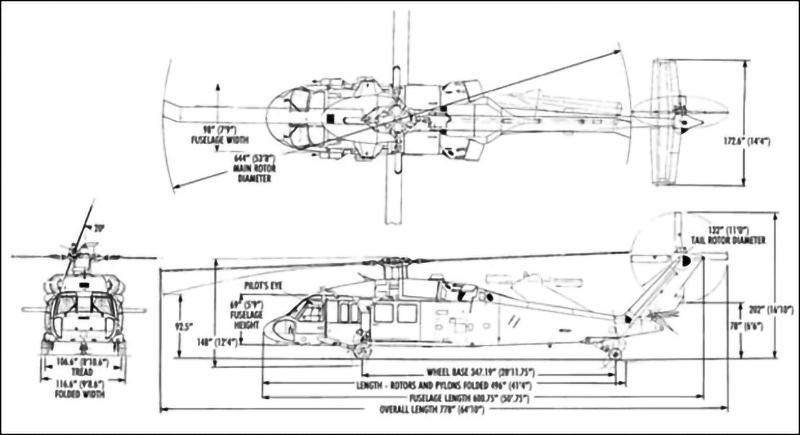Sikorsky Product History
Sikorsky S-70A: UH-60L Black Hawk Family
Background
The U.S. Army and Sikorsky Aircraft began development of the UH-60L model during 1987 to replace the “A” model whose performance capabilities were declining as a result of weight growth. The new “L” model was the first major upgrading of the basic Black Hawk helicopter since the first UH-60A model was delivered in 1978.
This upgrade, primarily in installed power, was needed to restore performance lost by the “A” model due to many weight increases during its 11-year production run of nearly 1000 units. During that period, the UH-60A model went through a maturing phase reflecting combat service experience combined with the rigors of high flight time and environmental stress particularly in the Middle East as well as other combat areas described in the UH-60A history accessible on this website.
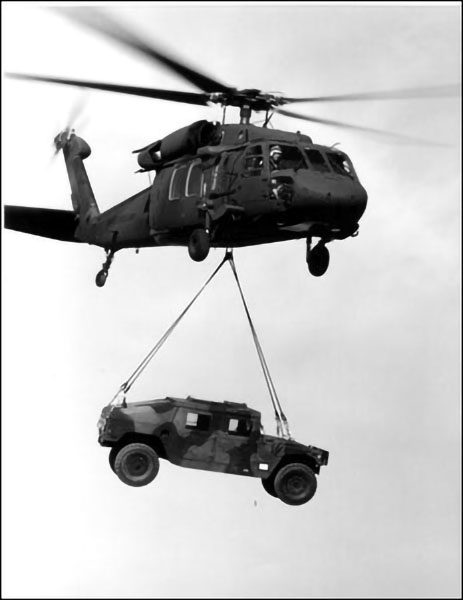
could transport the M1036 High Mobility Multipurpose Wheeled Vehicle,
HMMWV, weighing 8,750 lb.
The Army’s operational and combat experience indicated the need for features and equipment that were not envisioned when the Black Hawk program began. In addition, service experience showed that the reliability and durability of certain aircraft systems needed to be improved. As equipment and features were added and components were strengthened, weight growth of the UH-60A began to degrade aircraft flight performance. The development of the UH-60L model to replace the “A” model was intended to restore that lost performance especially in hot and high ambient conditions by upgrading its propulsion system.
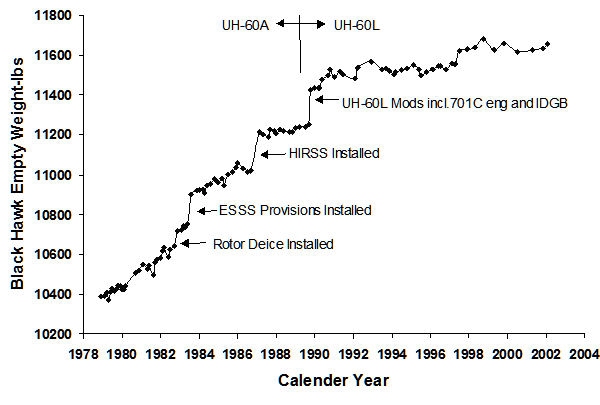
Each pound that was added reduced performance, particularly vertical climb capability and cruise speed, which finally fell below the Army’s minimum specification requirements of 450 fpm and 145 knots. The last UH-60A delivered weighed 11,253 lbs. against a specification weight that had also increased over the years to 11,284 lbs. reflecting the sum total all engineering change proposals and specification change notices issued since production started in 1976.
The power of the original T700-GE-700 engines was insufficient to achieve specification performance at that increased weight. Since higher power was needed to recover performance, the Army took advantage of the T700-GE401C engines developed by the Navy for the Seahawk program and created a version to power the new UH-60L model. Certain structural design changes were made in the propulsion system to accommodate the increased power.
Configuration Features
The external features of the UH-60L model were essentially unchanged from the “A” model. The significant improvements of the “L” model were in upratings of the propulsion and the flight control systems. No changes were made to the rotor systems. The main building blocks selected to create the “L” model were the uprated engines, improved durability main gearbox and strengthened flight controls developed several years earlier by the US Navy for its SH-60B Seahawk. The uprated Seahawk engines, identified as the T700-GE-701C for the Army, had an intermediate rated power of 1,857 SHP compared to 1,622 SHP for the T700-GE-700 engines that they replaced. The Seahawk’s improved durability gearbox was rated at 3,400 HP compared to 2,828 HP for the “A” model gearbox. This power rating increase was achieved by selectively increasing gear face widths, strengthening shafting and enlarging housings of the basic UH-60A main gearbox. Since its external geometry was essentially unchanged, this uprated gearbox was subsequently selected for other follow-on Black Hawk and Seahawk models.
With this substantial power increase, the UH-60L not only recovered performance lost by a decade of weight increases but it provided performance margins that extended mission capabilities much above the “A” model. For example, external load capacity increased from 8,000 to 9,000 pounds permitting the “L” model to transport many artillery weapons and vehicles that could not be carried by the “A” model. This increased performance also permitted development of much more advanced MEDEVAC models in addition to configurations tailored to the U.S. Army Special Forces and U.S. Air Force Special Operations Command as described below under Related Models.
General Arrangement Drawing
Mission Systems
The External Stores Support System (ESSS) made it possible for the Black Hawk to carry external fuel tanks and/or a wide variety of weapon systems. This system was developed during the UH-60A production period and it was also extensively used on the new UH-60L models. An overview of which weapons systems and fuel tanks that can be carried on the ESSS is provided in the UH-60A model description accessible on this Sikorsky Product History website.

General Characteristics and Performance
The performance and specifications presented below accurately describe the UH-60L model at a point in time. Some variation to these data can be expected as a result of subsequent engine power rating changes and aircraft design changes.
- Main rotor diameter: 53.6 ft., 4 blades, airfoil SC1095 and SC1094R8.
- Main rotor blade chord: 1.73 ft., tip swept aft 20 degrees, blade twist negative 18 degrees.
- Main rotor solidity: .083, main rotor tip speed: 725 fps.
- Main rotor head equivalent flapping hinge offset of 15 in.
- Tail rotor diameter: 11 ft., 4 blades; chord .81 ft., airfoil SC1095.
- Tail rotor solidity: .1875.
- Tail rotor tip speed: 699 fps.
- Main gearbox rated power: 3,400 HP.
- Main gearbox input/output speeds: 20,000/258 rpm.
- Installed power: Two T700-GE-701C engines, intermediate rated power: 1,857 HP at SL-STD conditions.
- Weight empty of the first production UH-60L: 11,426 lb.
- Mission gross weight of the first production UH-60L: 16,976 lb.
- External cargo hook capacity: 9,000 lb.
- Performance of the first production UH-60L: vertical rate of climb of 1,550 fpm and cruise speed of 152 knots at 4,000 ft. 95 degrees F.
Production History
The first UH-60L was delivered to the Army in 1989 at the same time that production of the UH-60A ended. Although production of the “L” model for the Army ended in 2006 when the UH-60M was phased in, the “L” model continued to be produced for international military organizations. As of this writing the UH-60L is still being produced for other customers and altogether over 1,000 have been built for all operators.
Related Models
The increased power and resulting improved performance of the “L” model made it the right airframe to configure for medical evacuation missions, which had grown in importance with the wars in Iraq and Afghanistan. The Army created a new specification for a dedicated MEDEVAC helicopter to be designed around the UH-60L airframe. It was designated as the UH-60Q DUSTOFF that was an acronym for “Dedicated Unhesitating Service To Our Fighting Forces”.
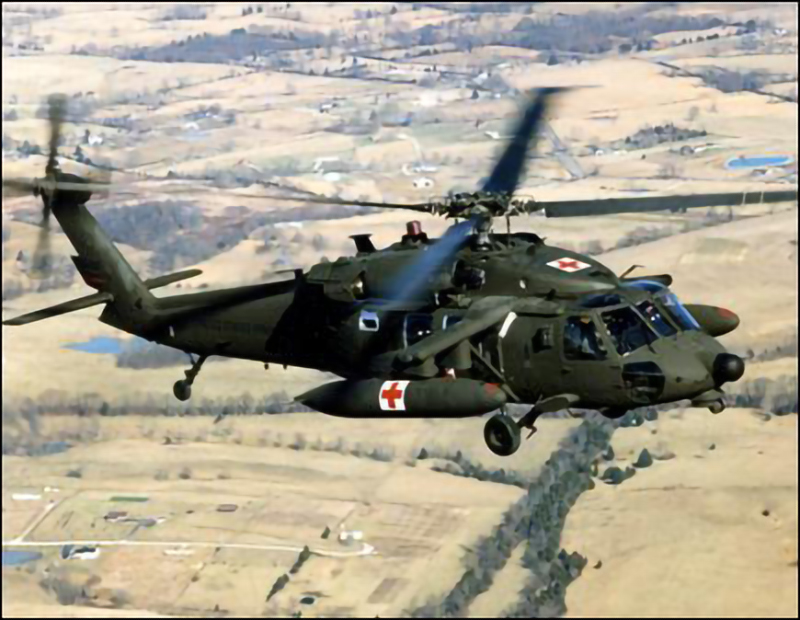
The UH-60Q was configured and equipped with high technology medical equipment including an oxygen generating system, an intravenous solutions warming and cooling unit, a cardiac monitoring system, a powered litter lift system and outlets for 28V dc as well as 110/220V ac electrical power and night vision compatible lighting. The new litter system could accommodate six acute care patients and provided far better patient access than did the original system designed many years earlier for the UH-60A.
The UH-60Q was also equipped with a cockpit-mounted Forward Looking Infra-Red (FLIR) system, weather radar, satellite communications and global positioning system. Its medical systems, range extension tanks and all-weather capability enabled it to perform battlefield evacuation, combat search and rescue, forward surgical team support as well as humanitarian relief missions.
Refinements of the UH-60Q continued to be made in medical care equipment, cockpit displays and communication/navigation systems leading to a new dedicated MEDEVAC model designated as the HH-60L. Following the HH-60L, the HH-60M model was developed that was based on the new UH-60M whose history is accessible on this Sikorsky Product History website.
The UH-60L provided the base airframe for several other models including the U.S. Air Force Pave Hawks series starting with the HH-60G. This model replaced the earlier U.S.A.F. MH-60G that was based on the UH-60A Black Hawk. The Air Force missions included long-range infiltration and recovery of special operation forces as well as recovery of downed pilots. Special equipment was installed to permit night and all-weather operation at long ranges. Both Pave Hawk models could be fitted with two 7.62 Minigun in the gunner windows or two 0.50 caliber guns in the cabin door opening. Approximately 100 Pave Hawks were delivered most of which were HH-60G models as of this writing.
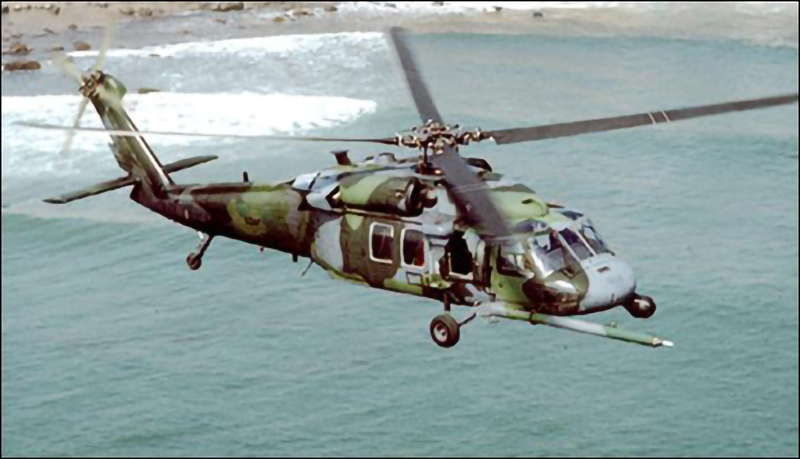
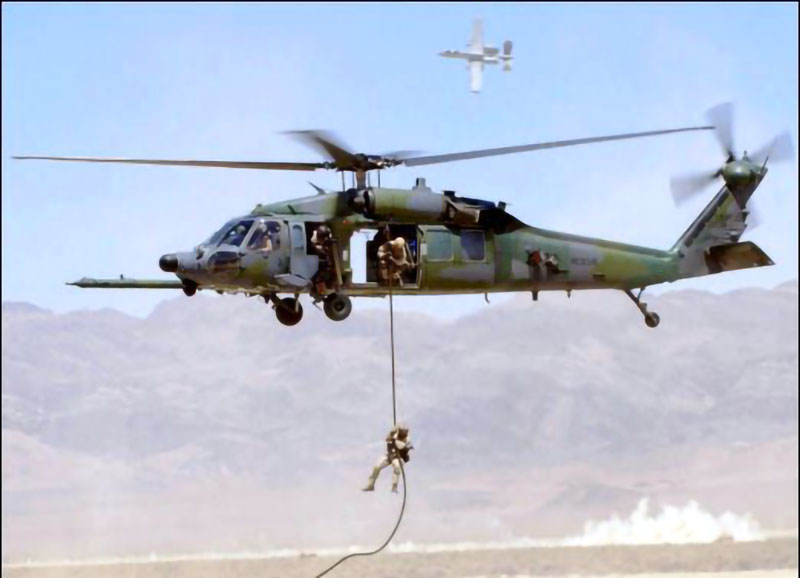
U.S. Army Special Forces variants included the MH-60A, which was a derivative of the UH-60A. Approximately 30 were built during the mid 1980s when they were superseded by the MH-60K whose development began in 1987. The “K” version first flew in 1990 with integration of mission equipment performed by the IBM Federal Systems Division. Its special features for long-range operation include enlarged internal fuel tanks (360 gallons), an aerial refueling probe and external tank system (ETS). It is also equipped with terrain avoidance radar and Forward Looking Infra-Red (FLIR) turret. Defensive equipment in addition to suppressive-fire weapons included a missile warning receiver, chaff dispenser and radar warning system.
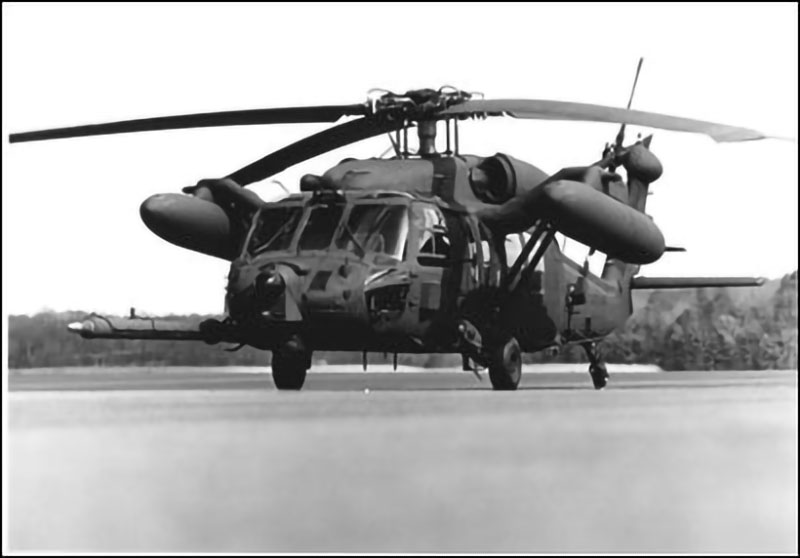
Additional Information Sources
Additional background and technical information regarding Black Hawk and Seahawk models can be found in the book entitled “Black Hawk, the Story of a World Class Helicopter” written by Ray D. Leoni and published by the American Institute of Aeronautic and Astronautics in 2007. ISBN-13:987-1-56347-918-2.
by Ray D Leoni
Related Articles
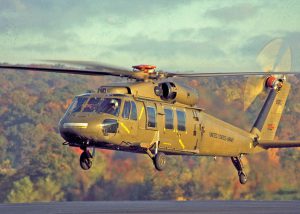
Sikorsky Takes the UTTAS Prize
The first flight of Sikorsky Aircraft’s Black Hawk occurred 50 years ago, on October 17, 1974. Since then, over 5000 Black Hawks have been delivered to customers, making it Sikorsky’s longest production program.
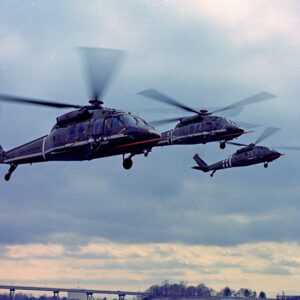
Bill Paul: Reflections on Sikorsky’s 100th Anniversary
Former Sikorsky President Bill Paul reflects on his career with Sikorsky, meeting Igor Sikorsky, and the Sikorsky Aircraft Company’s 100th anniversary.
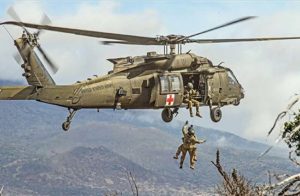
Sikorsky Lifts the Army
The U.S. Army saw the possibilities of the helicopter early in its development, thus beginning a relationship with Sikorsky Aircraft that continues to this day.
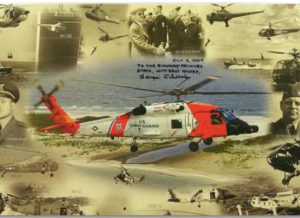
Sikorsky Serves the Coast Guard
A flight demonstration of Igor Sikorsky’s VS-300A helicopter at Bridgeport, Connecticut in April 1942 started an air-sea rescue revolution in the U.S. Coast Guard.
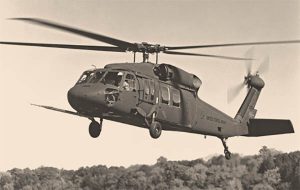
Bill Paul: Management Contributions to the Black Hawk Helicopter’s Success
Bill Paul recollects one of the key milestones of Sikorsky history, the win of the UTTAS program that became the Black Hawk helicopter.
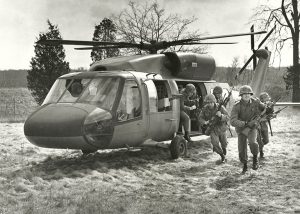
Ray Leoni: Recollections of a Sikorsky Junior Engineer
Ray Leoni recollects his 41-year career at Sikorsky Aircraft, beginning as a junior engineer and retiring as a Senior VP of Engineering and Advanced Programs.
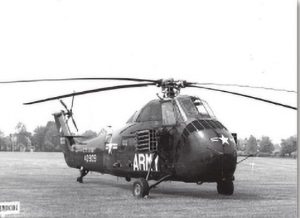
Evolution of the Armed Helicopter
Military users quickly understood the flexibility and fire-power of rotary wing platforms and ultimately evolved highly integrated weapons systems ready to protect themselves and others.
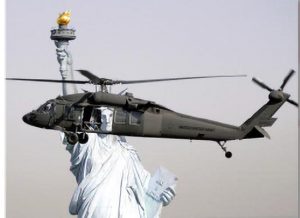
The Sikorsky Black Hawk in U.S. Military Service
When Black Hawk program manager Colonel Richard Kenyon received keys to Sikorsky’s first production UH-60A on October 31, 1978, the U.S. Army received the powerful, hardened assault helicopter it wanted.

Sikorsky Helicopters in U.S. Air Force Rescue Squadrons
The HH-60W Combat Rescue Helicopter is the latest in the life-saving line of Sikorsky helicopters made for U.S. Air Force Rescue Squadrons. The Whiskey will round out a century of vertical flight rescue heroism.
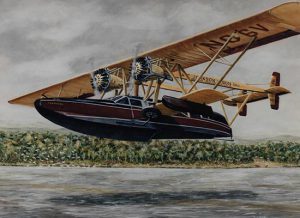
Sikorsky Aircraft Color Schemes
This issue of the newsletter illustrates some of the artistic variations in the exterior color schemes of aircraft delivered during Igor Sikorsky’s three careers.
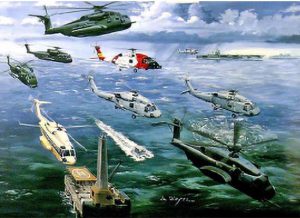
Sikorsky Aircraft Paintings by Andy Whyte
This issue of the newsletter is devoted to the aircraft designs and paintings by Andy Whyte, who had a 40 year career at Sikorsky Aircraft.

U.S. Coast Guard and Sikorsky Celebrate Significant Events
The United States Coast Guard and Sikorsky Aircraft celebrated two significant events in 2016. One century of United States Coast Guard aviation and the 127th birthday of Igor Sikorsky.

